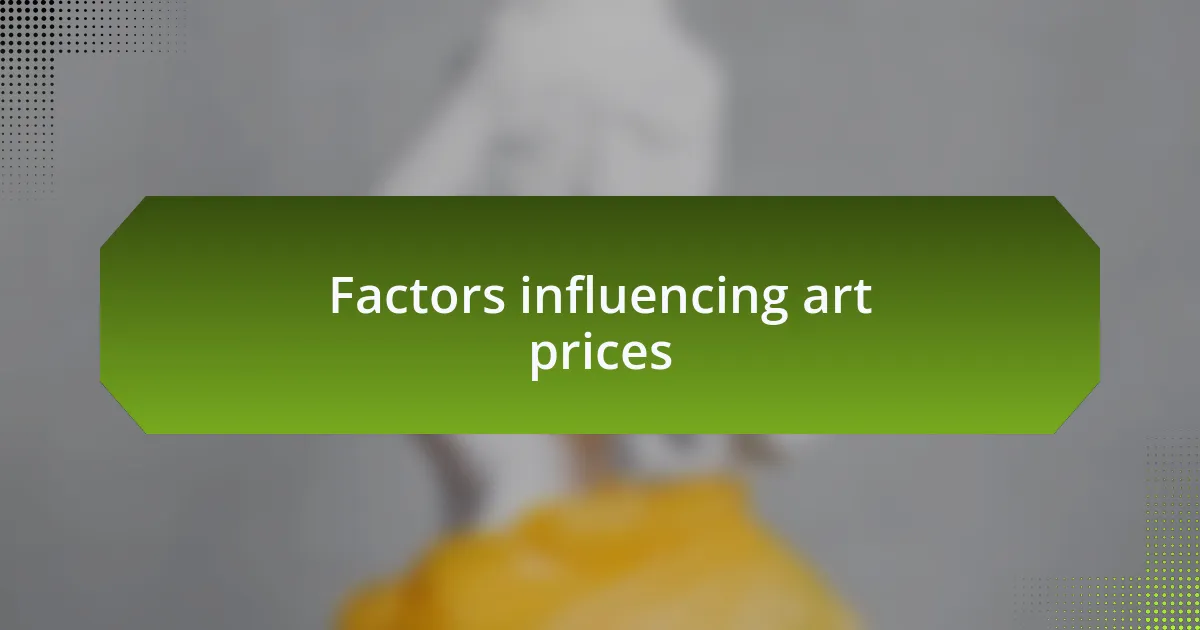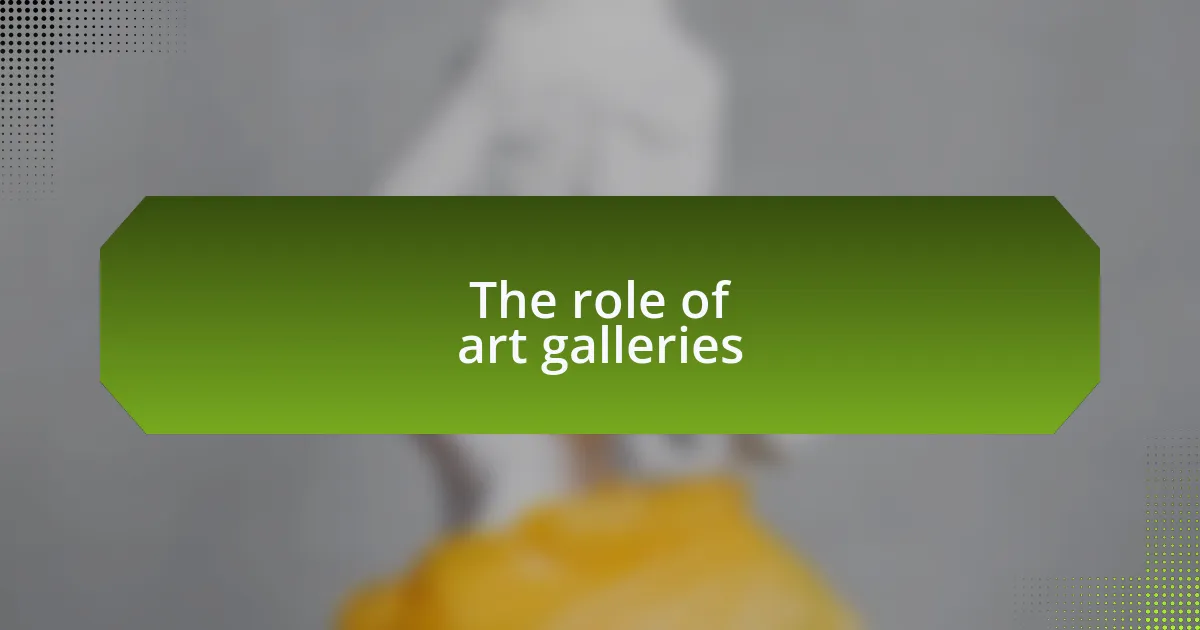Key takeaways:
- Art pricing is influenced by factors such as artist reputation, materials used, emotional resonance, and market trends.
- Galleries play a crucial role in enhancing art value through curation, education, and creating visibility for artists.
- Effective pricing strategies, including perceived scarcity and flexible pricing models, can impact sales and attract a diverse clientele.
- Artists should understand their costs, research comparable works, and engage with collectors to establish transparent pricing.

Understanding art pricing
Understanding art pricing is often a complex endeavor, influenced by various factors like the artist’s reputation, the materials used, and the emotional resonance of the piece. I remember attending an art fair once where some pieces were priced astronomically high, and I couldn’t help but wonder how much of that price was tied to the artist’s celebrity status rather than the actual work itself. Have you ever questioned why some art seems overpriced while others are quite accessible?
The process of determining art prices can feel a bit like negotiating a mystery. In my experience, galleries often base their pricing on a mix of market demand and the unique narrative behind the artwork. For instance, a piece that tells a compelling story or connects with cultural movements can command a higher price because buyers feel an emotional connection. Isn’t it fascinating how personal stories can elevate the value of art in the eyes of a collector?
Additionally, art pricing can fluctuate just like stocks, meaning it can be unpredictable. I recall a young artist whose work was initially deemed ‘too avant-garde’ and thus undervalued. Years later, a shift in trends made that same work highly sought after. This illustrates the importance of staying attuned to both market trends and personal tastes in art appreciation—how often do we overlook these dynamics when evaluating the price of a piece?

Factors influencing art prices
Art prices can be significantly influenced by the artist’s reputation and past sales history. I remember visiting a gallery where artworks by a well-known artist sold for tens of thousands of dollars, while lesser-known artists struggled to even gain attention. It made me ponder: how much does a name truly dictate value in the art world?
Another important factor is the quality and rarity of materials used in the artwork. For instance, I once purchased a painting that had intricate detailing made with gold leaf. It turned out that the materials alone contributed substantially to its value, which I hadn’t fully appreciated until a knowledgeable friend pointed it out. Doesn’t it make you think about how the physical composition of an artwork can affect its pricing?
Moreover, the context surrounding a piece can elevate its price—think of the story behind it. I recall a conversation with a collector who passionately described the history of a painting they owned, from its creation during a pivotal historical moment to its impact on contemporary culture. It struck me how the narrative behind art could transform perception and worth. How often do we consider the stories behind the canvas when evaluating price?

The role of art galleries
Art galleries play a vital role as intermediaries between artists and the public, providing a platform for exposure. I remember attending an exhibit featuring emerging artists, and the enthusiasm in the room was palpable. It struck me how galleries can create buzz around new talent, helping them gain visibility that would be difficult to achieve on their own.
In my experience, galleries also curate collections that enhance the value of the artworks they display. A visit to a gallery showcasing a themed exhibition transformed my understanding of contemporary art’s context. It was fascinating to see how arrangements and associations influenced my appreciation for each piece, crafting a narrative that elevated their significance and desirability.
Additionally, galleries educate potential buyers about the works presented. I vividly recall a gallery owner explaining the nuances of abstract art during an open house, which helped demystify complex concepts. This kind of dialogue not only enriches the viewer’s experience but also fosters a deeper connection between art and appreciation, ultimately impacting how we perceive value in art.

Pricing strategies for galleries
Pricing strategies for galleries can significantly influence how artworks are perceived and sold. I recall my surprise during a gallery walk when I encountered a piece priced much higher than others, only to find it was part of a limited series. This experience reminded me how perceived scarcity can create desirability, prompting me to consider what truly drives an artwork’s value.
Another effective pricing strategy lies in tiered pricing based on the artist’s reputation and market demand. There was a time when I attended an auction where lesser-known artists were grouped with more established ones, and it struck me how this method could elevate their status. It made me wonder: could this approach not only boost sales for newer talents but also give buyers a sense of being part of something transformative?
Lastly, incorporating flexible pricing models, such as payment plans or discounts for early purchases, can also attract a diverse clientele. I once overheard a collector express relief at being able to gradually pay for a significant artwork. This type of strategy not only opens doors for more buyers but also nurtures a loyal relationship between galleries and their patrons, which is crucial in the art world.

Personal experiences with art pricing
I remember attending a gallery opening where the artworks seemed to reflect the artists’ souls, yet the price tags left me scratching my head. One striking piece caught my attention, but it was priced well beyond my budget. It made me wonder: how do artists determine what their work is worth? For me, that moment highlighted the emotional attachment and personal stories behind pricing, which often go unnoticed.
I’ve also experienced the frustration of navigating the world of art fairs, where prices can vary dramatically from one booth to the next. At one particular fair, a vibrant abstract painting that I adored was way out of my range, but I learned from a gallerist that similar pieces by the same artist had once sold for much less. That experience made me think about how market trends can shift the perceived value of art so quickly, often leaving both buyers and sellers in a dizzying dance of speculation.
Finally, witnessing the negotiation process in art sales has given me a unique perspective. I remember standing quietly as a potential buyer tried to barter for a stunning sculpture, each back-and-forth exchange filled with tension and excitement. It struck me how pricing isn’t always set in stone; it can evolve based on conversations and relationships formed in those vibrant moments, encouraging me to appreciate the deeper connections art can foster between people.

Tips for pricing your art
When it comes to pricing your art, I’ve found that understanding your costs is crucial. I vividly recall my early days as an emerging artist, where I’d arbitrarily set prices without really knowing the expenses behind my materials and time. It wasn’t until I sketched out a detailed budget that I realized how critical it was to factor in every element—from the canvas to the hours spent creating each piece. Have you taken the time to tally your costs? It can illuminate the true value of your work.
Another tip I’ve picked up along the way is to look at comparable works in your niche. I once had a conversation with a seasoned artist who recommended researching prices of similar styles and techniques. It honestly opened my eyes. Seeing what others in your domain charge can provide a valuable benchmark, but it’s also essential to ask yourself: What makes your work unique? Perhaps it’s that distinctive flair or emotion that only you can express, and that should be reflected in your pricing strategy.
Finally, don’t shy away from engaging with your audience and collectors about prices. There was a time when I hesitated to discuss monetary values, fearing it would cheapen my art. However, when I began to share my thought process behind pricing with potential buyers, I found they appreciated the transparency. Has this ever happened to you? By fostering these conversations, you build trust and potentially open doors for negotiations, making your work more relatable and valued in the eyes of your audience.